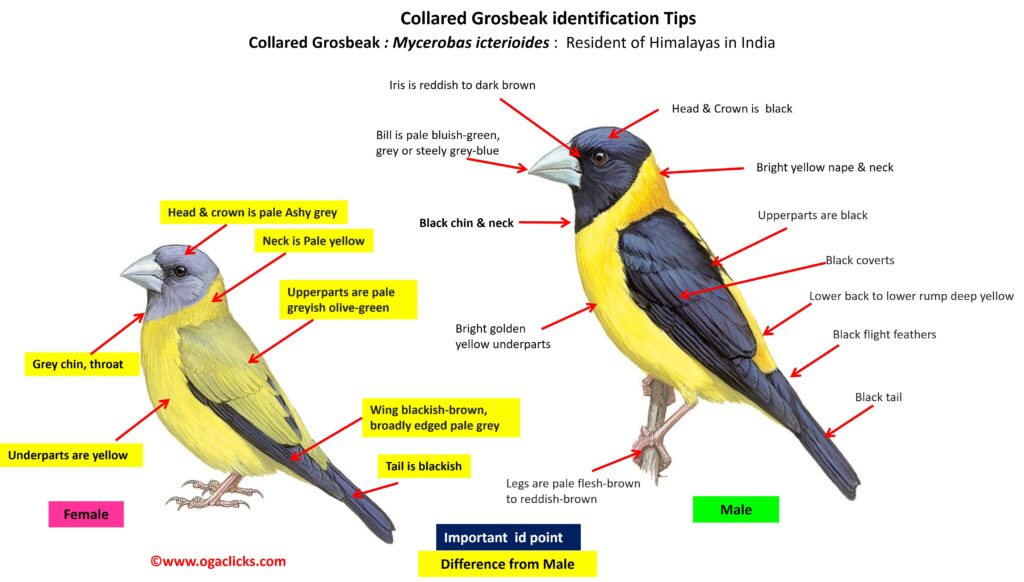Collared Grosbeak

Collared Grosbeak Mycerobas affinis
Etymology :
- Mycerobas : Greek word moukerobas –nut-breaker
- Affinis : Latin word for Related
Distribution in India: Resident of Himalayas
Description: Size of 20-22 cm .Male has entire head to upper nape, upper side of neck and lower throat black, glossy on crown and face; nape to mantle and lower side of neck yellow, heavily tinged golden-brown, lower mantle and upper back black, broadly streaked yellow, lower back to lower rump deep yellow, tinged golden-brown, upper tail-coverts black; side of mantle to wing and tail black, scapulars and central tail feathers glossy, greater upper wing-coverts and tertials glossy; underparts bright deep yellow; iris reddish-brown to dark brown; bill pale bluish-green, grey or steely grey-blue; legs pale flesh-brown to reddish-brown. Female has head to nape, upper side of neck and lower throat ,pale ashy grey, lores slightly darker grey; lower nape and upperparts pale greyish olive-green, sometimes slightly duller olive on mantle and scapulars and paler or brighter green on rump and upper tail-coverts; tail black or blackish-grey; median and greater upper wing-coverts fringed bright olive-green to golden-olive, rest of wing black, broadly edged bright olive-green on secondaries and outer edge of tertials; lower side of neck, side of breast and remaining underparts yellow, sometimes tinged olive-buff; bill as on male or paler green or greyish-green.
Habitat: It is found lower montane and sub montane mixed deciduous and conifer forests, mostly consisting of silver fir (Abies pindrow) and hemlocks (Tsuga), and conifer stands and woods, also in maple (Acer), birch (Betula), oak (Quercus) and rhododendrons (Rhododendron), as well as dwarf juniper (Juniperus) above the tree-line
Food Habits: It eats variety of seeds, including those of pine (Pinus), also buds, shoots and fruit, including crab apples (Malus) and nuts; in summer takes small insects, larvae and snails Forages in upper canopy of trees and lower down in bushes, low vegetation or on the ground. Uses strong bill to extract pine seeds from cones. Forages in pairs and in small, loose or scattered groups;
Breeding Habits: They breed in Mar-July. Displaying pairs follow each other through forest undergrowth while calling loudly. Nest a flat cup mostly of twigs, plant fibers and lichen, placed high up on horizontal branch in tall conifer. Clutch of 2–3 eggs, incubation by both sexes, mainly by female, period 15–16 days; nestling period 17–18 days; young fed by parents for at least one week and possibly for up to two months after leaving nest.